
Fertilize the egg by sprinkling it with a moderately adjusted concentration
of sperm.

A single sperm is directly inserted into the egg cell using a fine needle under a microscope.
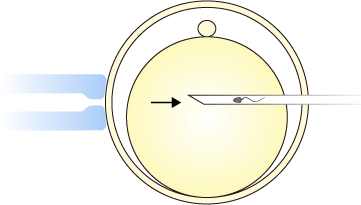
For in vitro fertilization(IVF), there is the standard method called Conventional IVF where it is allowed to fertilize by sprinkling the oocyte with a moderately adjusted concentration of sperm, and there is micro-insemination(ICSI), in which a very slim needle is used and 1 sperm is placed directly within the oocyte cell underneath a microscope.
Basic information about IVF is posted here.
This is the method of allowing the oocyte to fertilize by sprinkling sperm on the oocyte.
In the cases of fallopian tubal infertility, male infertility, anti-sperm anti-body, or when you can’t get pregnant by standard infertility treatments, or it is a case of the age factor, this will become the adaptation.

Cells called granulose cells(cumulus cells) are attached to the surroundings of the oocyte collected.
This is called the “cumulus cell oocyte complex”(COC).
For IVF, we will sprinkle an adjusted concentration of sperm on the COC(this is called, “amphipathic”).
Then, many sperm will gather around the COC, and from the head hyaluronidaze will be released and will melt the granulose cell.
After that, the sperm will pass through the “shell”(transparent body) of the oocyte within the granulose cell, fuse with it and fertilization is complete.
From the head of the sperm hyaluronidaze is released and the granulose cell is dissolved. Several sperm are necessary and the suitable concentration should be around 100,000/ml. |
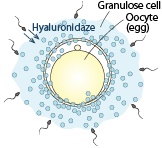 |
The sperm that dissolved the granulose cell, also dissolves the translucent body and enters the oocyte cell. |
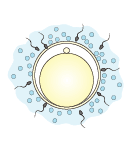 |
As soon as the first sperm arrives at the oocyte cell, a change occurs with the translucent body and the oocyte cell’s membrane, and other sperm will be denied access to enter. |
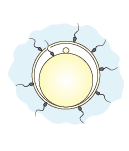 |
The sperm that enters the oocyte cell along with the oocyte form a pronucleus and finally fuse together. |
 |
This is the method of injecting sperm into the oocyte by the use of a needle underneath a microscope.
The official name is the IntraCytoplasmic Sperm Injection Method(ICSI).
They are the cases of severe male infertility(can not achieve an adequate number of motile sperm with conventional IVF), and fertilization failure(will not fertilize with IVF).
Even when the sperm is injected into the oocyte it will not fertilize. If the tail portion of the sperm is taken with the ICSI needle, then the sperm will fail to move(immobility of sperm), and we will have to acquire fertilization. |
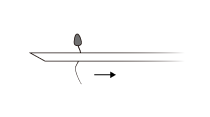 |
We will take the immobile sperm with the ICSI needle and just like that pierce the oocyte. |
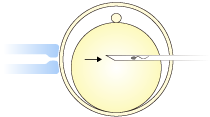 |
A small amount of the oocyte cytoplasm will be sucked up into the ICSI needle, and the sperm with the cytoplasm are injected into the oocyte. |
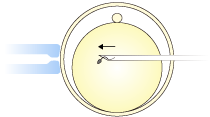 |
State of Micro-insemination(ICSI)